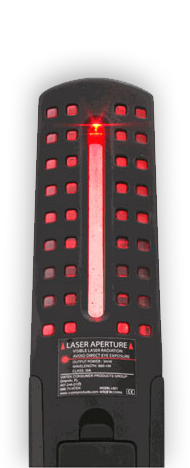Low Level Laser
In 1964, Professor Andre Mester began experimenting with the use of low-power laser energy in Budapest, Hungary. He observed that low energy laser exposure has a stimulating effect on the biological system, while high-energy laser exposure had an inhibiting effect. In his experiments with wound treatment on mice, he noticed rapid healing due to microcirculation of blood supply. This healing was also obvious in laser light treatment of diabetic patients suffering with dystrophic sores. He was amazed to find sores that would not otherwise heal were healed, and he also observed accelerated hair growth and thickening of hair in the treated areas. This theory through its evolution has since been refined and is widely becoming one of the most popular non-invasive hair loss treatments.
Laser researcher Dr. J. Layton Wright states: … "Laser Hair Therapy increases microcirculation of the hair follicle, which allows nutrients and freshly oxygenated blood to access the hair follicle with the results being a stimulation of the natural hair growth cycle."


What Is Low Level Laser ?
Low Level Laser is a term adopted by the laser therapy community to differentiate this form of treatment from high power lasers such as those used in surgery. Low Level Laser and, lately, Light Therapy are commonly abbreviated as LLLT. The laser energy produced by the LaserComb is within the accepted level of LLLT. The HairMax uses a laser diode operating in the red portion of the visible color spectrum. Laser energy is different from natural light in several ways. It is monochromatic, which means all the energy is essentially one wavelength or color whereas a light bulb produces a broad spectrum of light and energy waves. Laser energy is also collimated which means it is a tight beam of light energy that spreads or diverges only a little at great distances while a light bulb loses its brightness very quickly with distance.
And laser energy is also coherent. All energy consists of waves of energy and in the light bulb these waves are not organized or in sync with each other. The waves of light energy produced by a laser are synched or in phase with each other. These characteristics make laser energy a truly unique form of light energy.
The same European group of scientist's published their findings on LLLT use in the treatment of alopecia and crural ulcers in 1998. The authors tried to verify the efficacy of LLLT in scalp alopecia and crural ulcers of different causes. Laser used was (red diode, continuous emission, 8 mW power, wave length 670 nm spot size about 5 mm diameter on some points. They also use as control classical therapy. Before, during and after treatment, histological samples were taken from alopecia regions. For the laser groups (alopecia and ulcers) the results were rather superior and in a three or twice time shorter than the control group. They conclude that LLLT therapy is a very useful complementary method for the treatment of scalp alopecia and crural ulcers.
High Power Lasers vs. Low Level Laser
There are two types of lasers: high power and low power. High power lasers are used to cut through tissue and give off heat. Low level laser on the other hand does not give off heat and uses photo energy.
The Ozzie Hair Pro Laser Brush and Treatment Program
The laser used in this brush is the result of 18 years of use and research.All Tests were done in The USA The Aussie hair pro brush complies with laser product safety standards Its half the cost of other conpetitors in the Market. Dual Laser & LED brush uses technologies proven to promote richer, fuller hair. Worlds first! Works anywhere no charger required unlike Hair Max laser comb.



